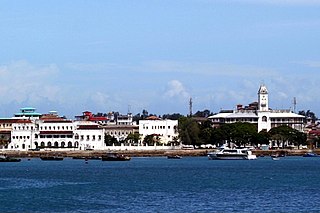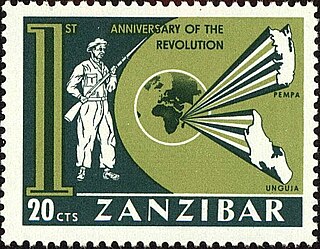
Zanzibar is an insular semi-autonomous region which united with Tanganyika in 1964 to form the United Republic of Tanzania. It is an archipelago in the Indian Ocean, 25–50 km (16–31 mi) off the coast of the African mainland, and consists of many small islands and two large ones: Unguja and Pemba Island. The capital is Zanzibar City, located on the island of Unguja. Its historic centre, Stone Town, is a World Heritage Site.

Stonetown of Zanzibar, also known as Mji Mkongwe, is the old part of Zanzibar City, the main city of Zanzibar, in Tanzania. The newer portion of the city is known as Ng'ambo, Swahili for 'the other side'. Stone Town is located on the western coast of Unguja, the main island of the Zanzibar Archipelago. Former capital of the Zanzibar Sultanate, and flourishing centre of the spice trade as well as the Indian Ocean slave trade in the 19th century, it retained its importance as the main city of Zanzibar during the period of the British protectorate. When Tanganyika and Zanzibar joined each other to form the United Republic of Tanzania, Zanzibar kept a semi-autonomous status, with Stone Town as its local government seat.

SayyidBarghash bin Said al-Busaidi, an Afro-Omani Sultan and the son of Said bin Sultan, was the second Sultan of Zanzibar. He ruled Zanzibar from 7 October 1870 to 26 March 1888.

Sayyid Saïd bin Sultan al-Busaidi was Sultan of Muscat and Oman, the fifth ruler of the Busaid dynasty from 1804 to 4 June 1856. His rule began after a period of conflict and internecine rivalry of succession that followed the death of his father, Sultan bin Ahmad, in November 1804. He is often referred to as the Lion of Oman, as one of the greatest Omani sultans.

Taarab is a music genre popular in Tanzania and Kenya. It has been influenced by the musical traditions of the African Great Lakes, North Africa, the Middle East, and the Indian subcontinent. Taarab rose to prominence in 1928 with the advent of the genre's first star, Siti binti Saad.

The Afro-Shirazi Party (ASP) was an African nationalist and socialist Zanzibari political party formed between the mostly Shirazi Shiraz Party and the mostly African Afro Party.

Abeid Amani Karume was the first President of Zanzibar. He obtained this title as a result of a revolution which led to the deposing of Sir Jamshid bin Abdullah, the last reigning Sultan of Zanzibar, in January 1964. Three months later, the United Republic of Tanzania was founded, and Karume became the first Vice President of the United Republic with Julius Nyerere of Tanganyika as president of the new country. He was the father of Zanzibar's former president, Amani Abeid Karume.

The Anglo-Zanzibar War was a military conflict fought between the United Kingdom and the Sultanate of Zanzibar on 27 August 1896. The conflict lasted between 38 and 45 minutes, marking it as the shortest recorded war in history. The immediate cause of the war was the suspicious death of the pro-British Sultan Hamad bin Thuwaini on 25 August 1896 and the subsequent succession of Sultan Khalid bin Barghash. The British authorities preferred Hamoud bin Mohammed, who was more favourable to British interests, as sultan. The agreement of 14 June 1890, instituting a British protectorate over Zanzibar, specified that a candidate for accession to the sultanate should obtain the permission of the British consul; Khalid had not fulfilled this requirement. The British considered this a casus belli and sent an ultimatum to Khalid demanding that he order his forces to stand down and leave the palace. In response, Khalid called up his palace guard and barricaded himself inside the palace.

Emily Ruete, was a Princess of Zanzibar and Oman. She was the youngest of the 36 children of Said bin Sultan, Sultan of the Omani Empire. She is the author of Memoirs of an Arabian Princess from Zanzibar.

The Zanzibar Revolution began on 12 January 1964 and led to the overthrow of the Sultan of Zanzibar Jamshid bin Abdullah and his mainly Arab government by the island's majority Black African population.
People have lived in Zanzibar for 20,000 years. The earliest written accounts of Zanzibar began when the islands became a base for traders voyaging between the African Great Lakes, the Somali Peninsula, the Arabian Peninsula, Iran, and the Indian subcontinent. Unguja offered a protected and defensible harbour, so although the archipelago had few products of value, Omanis and Yemenis settled in what became Zanzibar City as a convenient point from which to trade with towns on the Swahili Coast. They established garrisons on the islands and built the first mosques in the African Great Lakes Region.

The House of Wonders or Palace of Wonders is a landmark building in Stone Town, Zanzibar. It is the largest and tallest building of Stone Town and occupies a prominent place facing the Forodhani Gardens on the old town's seafront in Mizingani Road. It is located between the Old Fort and the Palace Museum. It is one of six palaces built by Barghash bin Said, second Sultan of Zanzibar, and it is said to be located on the site of the 17th-century palace of Zanzibari queen Fatuma. The House of Wonders housed the Museum of History and Culture of Zanzibar and the Swahili Coast.

The Old Dispensary, also known as Ithnashiri Dispensary, is a historical building in Stone Town, Zanzibar. It is located on the seafront, in Mizingani Road, halfway between the Palace Museum and the harbour. It owes its name to the fact that it served as a dispensary in the first half of the 20th century.
Tanzanian nationality law is regulated by the Constitution of Tanzania, as amended; the Tanzania Citizenship Act, and its revisions; and various international agreements to which the country is a signatory. These laws determine who is, or is eligible to be, a national of Tanzania. The legal means to acquire nationality, formal legal membership in a nation, differ from the domestic relationship of rights and obligations between a national and the nation, known as citizenship. Nationality describes the relationship of an individual to the state under international law, whereas citizenship is the domestic relationship of an individual within the nation. Commonwealth countries, including Tanzania, often use the terms nationality and citizenship as synonyms, despite recognising their legal distinction and the fact that they are regulated by different governmental administrative bodies. For much of Tanzania's history racist policy curtailed domestic rights and nationality. Tanzanian nationality is typically obtained under the principle of jus soli, i.e. by birth in the territory, or jus sanguinis, i.e. by birth in Tanzania or abroad to parents with Tanzanian nationality. It can be granted to persons with an affiliation to the country, or to a permanent resident who has lived in the country for a given period of time through naturalisation.
The Old Boma of Dar es Salaam, Tanzania is one of the city's oldest buildings. It is located at the crossing of Morogoro Road and Sokoine Drive, facing the harbor and adjacent to the City Hall. It was built in 1866-67 by Majid bin Said, sultan of Zanzibar, close to his palace. He also commissioned other buildings in the same area, such as the White Fathers' House. Under German colonial rule it was restored and enlarged. Distinctive features of the building include the zanzibari-style carved wooden door and coral stone walls.

Hussein Ali Mwinyi is the 8th president of Zanzibar. The son of former Tanzanian president Ali Hasan Mwinyi, he is a member of the Chama Cha Mapinduzi (CCM) political party.
The following is a timeline of the history of Zanzibar City, Unguja island, Zanzibar, Tanzania. The city is composed of Ng'ambo and Stone Town. Until recently it was known as Zanzibar Town.
Zanzibari independence is a political ambition of some political parties, advocacy groups, and individuals of Zanzibar, a semi-autonomous region territory within Tanzania, to become an independent sovereign state.
A Swahili door or Zanzibari door is a door that was developed in the Swahili coast during the Middle Ages and peaked in the 19th century. The door is usually the first and foremost key element of Swahili architecture and was the historically first item that was built before the rest of the home.

Germany–Tanzania relations are the bilateral relations between Germany and Tanzania. From 1885 to 1918, Tanzania was a German colony as part of German East Africa. In the 21st century, relations are primarily characterized by the joint development cooperation.















